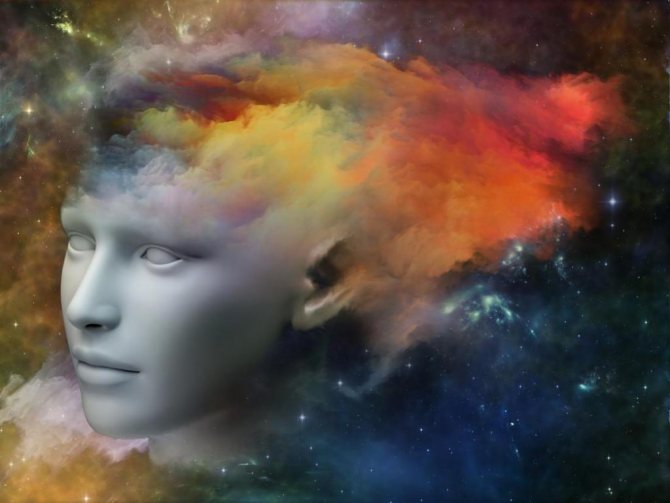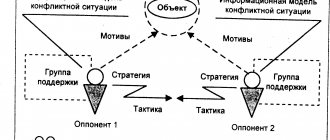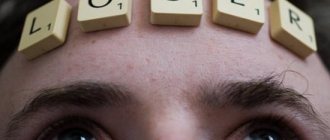The concept of synesthesia in psychology, who are synesthetes
Synesthesia in psychology is a peculiar neurological phenomenon in which cognitive-sensory perception in synesthetic people differs from other people.
At the same time, synesthetes perceive in a special way such things and concepts as:
- time categories – days of the week, months;
- generally accepted alphabetic and numeric symbols;
- some phenomena of reality - dishes, songs;
- personal emotions – pain, fear, joy.
A special synesthetic perception lies in the fact that any of these concepts, passing through the subjective prism of such a person’s worldview, acquires additional qualitative characteristics - for example, when hearing the word Friday, such people may have certain color or sound associations.
In other words, synaesthetes combine several human senses of perception when they come into contact with any object. Such people not only hear music, but also say that they feel it, and also distinguish it by smell and even see it. Moreover, this phenomenon is not something abnormal, but rather relates to the peculiarities of the functioning of the psyche of such people.
Features of the manifestation of synesthesia in humans
CONTENT
INTRODUCTION……………………………………………………………………………….3
1. THEORETICAL BASIS FOR THE RESEARCH OF THE CONCEPT OF “SYNAESTHESIA”……………………………………………………………………………………….4
1.1 Definition of the phenomenon “synesthesia”…………………………………….4
1.2. Types of synesthesia…………………………………………………..7
1. 3 Psychological methods for studying this phenomenon……………..11
2.PRACTICAL STUDY OF THE MANIFESTATIONS OF SYNAESTHESIA IN PERSONS WITH DIFFERENT TYPES OF TEMPERAMENT……………………………………………………..16
2. 1 Organization and methods of experimental work……………………..16
2.2 Research results……………………………………………………23
CONCLUSION…………………………………………………………….29
LIST OF REFERENCES…………………………….31
INTRODUCTION
The phenomenon in question, called “synesthesia,” has become known since the beginning of the eighteenth century. The content of the concept has historically changed from the period of its first mention in 1772 as a pathological sign to metaphorical thinking in the modern interpretation of the phenomenon. To date, there is no unambiguous interpretation of it. Definitions existing in different scientific disciplines complement each other, but do not give a clear opinion about the phenomenon as a whole. This demonstrates the relevance of this work. In the history of psychological science, the study of this concept is found in B. M. Teplov, M. G. Yaroshevsky, V. A. Yakunin, E. V. Levchenko and others.
Hypothesis: We hypothesize that temperament type may somehow influence the manifestation of synesthesia. Under the same conditions, people with different types of temperament can achieve equally successful results in different ways.
The object of this study is the manifestation of synesthesia in sound and color.
Subject of research: consideration of the characteristics of the manifestation of this phenomenon in persons of different types of temperament.
Purpose of the study: to identify features of the manifestation of synesthesia in people with different types of temperament.
1. Research objectives: to conduct a theoretical and methodological analysis of the concept of “synesthesia”; identify the psychological characteristics of synesthesia in humans; to conduct an empirical study of the manifestation of synesthesia in individuals with different types of temperament (using the example of high school students in a secondary school).
To solve the problems, the following methods were used: modeling, analysis and synthesis, study of philosophical and psychological-pedagogical literature; observation, method of expert assessments, experiment.
Research base: experimental work was carried out on the basis of an educational institution. 10th grade students took part in the study.
The course work consists of an introduction, two chapters, a conclusion and a list of references, including 24 sources.
1. THEORETICAL BASIS FOR THE RESEARCH OF THE CONCEPT OF “SYNAESTHESIA”
1.1 Definition of the phenomenon of “synesthesia”
In Russian psychology, the concept of “synesthesia” has become famous thanks to the research of such psychologists as: A. R. Luria, I. D. Ermakov, L. A. Shifman, S. V. Kravkov, B. G. Ananyev, R. G. Natadze and others. A. R. Luria interpreted synesthesia as a form of interaction between the senses, their common activity, “in which the qualities of sensations of one type (for example, auditory) are transferred to another type of sensation (for example, visual)” [4, p. 108]. Synesthesia is simultaneous sensation, shared feeling. It should be borne in mind that synesthesia is not a mental disorder.
Synesthesia (from the Greek synaisthesis - joint feeling, simultaneous sensation) is a phenomenon consisting in the fact that any stimulus, acting on the corresponding sensory organ, in addition to the will of the subject, causes not only a sensation specific to this sensory organ, but at the same time also an additional sensation or idea characteristic of another sense organ [21].
Synesthesia is called, first of all: a) intersensory connections in the psyche. But, in addition, the results of their manifestations in specific areas of art are also called synesthesia: b) poetic tropes and stylistic figures associated with intersensory transfers; c) color and spatial images evoked by music; and even d) interactions between the arts (visual and auditory) [15].
Psychologists write that this phenomenon can manifest itself in explicit and implicit forms. In an explicit form, according to a number of studies, synesthesia is observed in approximately fifty percent of children and fifteen percent of adults [17].
Psychologists, when describing synesthesia, mean intersensory associations. An example of synesthesia is the perception of music and letters in color.
Synesthesia is discovered against the will of the “synesthete” person at the subjective level. The unusual nature of synesthetic perception lies in the involuntary additional reaction. Synesthesia is not a sensory association, but a direct result of brain activity itself.
A study of synesthesia by a team led by Julia Simner in the UK through self-reporting on a random demographic sample found that synesthesia had a prevalence of 4.4 percent, with the most common type being the feeling of days of the week in color.
Psychological research shows that the brain of a synesthete is structurally arranged in a special way at the macro and micro levels. Functionally, the brain of a synaesthete, at least at the moment of synaesthetic perception, also differs from the activity of the brain of a non-synaesthete and from the work of the brain of the same synaesthete, but at the moment of perception of non-synaesthetic stimuli [13, p. 8]. Synesthetes are more sensitive to stimuli that cause synesthesia in them. They are endowed with more intense perception, especially in the sensory plane that includes their synesthetic reactions. Their consciousness is more saturated with sensory qualities [13, p. 9]. They see letters and numbers, words in color. In most cases, words are tasted, smells and sounds are distinguished by colors. On a social network, groups of people endowed with these abilities are created and discuss who sees and feels what and how. V. Luchko notes in his article that he feels differently at different periods of his life. At 8 years old - the aftertaste of halva at the back of the brain, at 13 years old - cinnamon with sugar, a little peppery and pleasantly spicy on the sides of the brain, at 18 years old - like the feeling of being intoxicated with water after a strong thirst, at the bottom of the brain, at 19 years old - the smell of aloe at the bottom of the brain [18]. Synesthetes note that synesthesia helps in life by systematizing the memory process. Synesthesia helps to remember and remember names, numbers, phone numbers, dates as color spots. Synesthesia begins in early childhood.
Until 1964, this concept was characterized by frequent changes in names: “inadequate sensations”, “color hearing”, “synopsia”, “color hearing”, “false secondary sensations”, “synopsia”, “synesthesia”. Further, there is a period when in psychology, medicine, psychiatry, philosophy there is a common name “synesthesia”, but there is a different interpretation of the concept.
In theories about synesthesia, domestic and foreign researchers have discovered the following basic provisions: part of the symbolic cognitive ability is allocated to synesthesia; the ability to delay functional semantic reactions contributes to the development of synaesthetic states; the presence in a person of the ability to determine the modal correlation of a stimulus may indicate the symbolic nature of the phenomenon of synesthesia, which brings them aesthetic experiences; Synesthesia occurs at the level of intermodal interactions, and at the linguistic level it is presented in the form of synaesthetic metaphors. The mutual translation of understanding from the level of meaning to the level of perception is accomplished using metaphor. Synaesthetic metaphors in artistic creativity since the mid-eighteenth century have performed the following functions: they contribute to the spread of the phenomenon both in the arts and in everyday speech; serve as an object of study in theories of art (theories of synesthetic phenomena). Manifestations of synesthesia indicate a violation of synchrony between the hemispheres of the brain. Hence, the synesthete often controls both the right and left hands equally.
Biographical data confirms that famous personalities were endowed with synesthetic perception: physicist R. Feynman, writer V.V. Nabokov, composers F. Liszt, D. Ligeti, O. Messiaen, J. Sibelius and others. According to leading Western researchers, synesthesia is associated with human creative abilities. The wide prevalence of intersensory images in language and various kinds of sensory means in art practically equate involuntary synesthetic reactions with a creative act.
The desire of people with synesthesia to create is largely prompted by their unusual experience, which, with its similarity to certain forms of art, motivates them to an appropriate way of self-expression.
The hypothesis about the connection between memory and synesthesia was tested by the following experiment. The subject was presented with matrices consisting of fifty digits. Without hesitation, he copied from memory on a piece of paper all the numbers that were shown to him within a few seconds. A day later, he repeated the test with the same result, despite looking a second time at the presented numbers in the matrix. Experience explains why synesthesia helps to remember unfamiliar and unrelated objects. For each number, the subject had his own color scheme, which was remembered like a picture [24].
1. 2 Types of synesthesia
Synesthesia is a phenomenon whose causes can be varied. Based on the reasons, synesthesia is divided into types: intoxication, traumatic, hypnagogic and hypnopompic, deprivation synesthesia, synesthesia in an altered state of consciousness (AS-synesthesia) and others.
In psychological sources we find: musical-color synesthesia - the perception of music in the form of naturally and involuntarily manifested color spots, stripes, waves; grapheme-color - the appearance of color associations with the outlines of letters or numbers; phoneme-color - the connection between the sound of human speech and different colors; phonemic-gustatory - the emergence of taste associations from the sound of individual words
Approximately sixty types of synesthesia with different stimulus and response characteristics have been recorded. The most popular type of stimulus is graphemes and music, followed by sound stimuli and time units, gustatory, visual and olfactory stimuli; in more rare cases, human images, pain and touch are experienced as stimuli, while temperature, feelings, orgasm and kinesthetics are in the minority. In the area of reactions, color prevails, followed by sound sensations, tactility and smell; taste, temperature and kinesthetics occur in less than one percent of cases [13, p. 10].
One of the classification characteristics is the division of all types of synesthesia, regardless of the content of stimuli and reactions, into projective and associative [13, p. 10].
Cases of experiencing sensory qualities related to the perceptual-objective field are called projective. Using visual synesthesia as an example, reactions are experienced in the form of color projections layered on stimulus objects or located outside a certain locus, but not completely blocking the field of perception. [13, p. 10]. Associative types are revealed only in the form of constant, involuntary representations. At the same time, scientists confirm the possibility of intermediate options.
Human sensitivity is determined by five analyzers, each of which is responsible for certain sensations: visual, auditory, olfactory, gustatory, tactile.
The most common form of synesthesia is the color scheme when mentally depicting a certain object. Auditory synesthesia is characterized by associations of sounds with predetermined colors. A person listens to classical music and imagines it in colors. Gustatory synesthesia is characterized by the perception of a certain object or subject in connection with some taste.
The main characteristics of true synesthesia, in contrast to false one, are involuntary occurrence and complete uncontrollability by consciousness. Let's say a person sees the number one as black and the number two as purple. Then the number twelve will be colored with a black and purple stripe. The number 212 will have two purple stripes with a black stripe in between.
In order to speak correctly about synesthesia and accurately analyze it, one should first point out that there are four large groups: congenital synesthesia, post-traumatic, intoxication and associated with altered states of consciousness (ASC), such as meditation, trance, and with transitions from wakefulness to sleep and from sleep to wakefulness (hypnagogic and hapnopompic states) [20].
By calling a certain type “phoneme-gustatory” synesthesia, it is implied that the owner of this type synesthetically feels some kind of taste in the mouth. At the same time, synesthetes with “phoneme-gustatory” synesthesia talk about sensations of texture and temperature.
As E. Schon notes, when researchers and the media talk about “synesthesia” and “synesthetes,” they are actually talking about only some subgroups of them. We find, by definition, various causes that cause synesthesia. Each of these groups covers some variety of synesthetic manifestation, and all four groups should be studied as separate varieties. E. Schon emphasizes that the presence of synesthesia in a person belonging to any of these groups does not exclude the possibility of its manifestation in other types. E. Sean himself, as a person with congenital synesthesia, many times experienced synesthesia caused in a state of trance, experienced intoxication and post-traumatic synesthesia, not counting countless cases of synesthesia when falling asleep. These synesthetic experiences were radically and qualitatively different from the sensations associated with congenital synesthesia. Synaesthetic manifestations belonging to different groups can be experienced simultaneously. There have been cases where a synesthete experienced reactions of both congenital and intoxication synesthesia.
Theories of origin
Today, there is no consensus among psychologists about why exactly synesthesia develops.
There are several hypotheses explaining the appearance of this phenomenon:
- genetic or congenital feature;
- cross-activation theory;
- "children's" theory.
Congenital feature
People inherit synesthetic characteristics of reality perception from their parents. At the same time, the initial appearance of synesthesia in someone in the family was facilitated by the mutation of certain genes responsible for the perception of various concepts, categories and objects.
One of the most famous synesthetes is the writer Vladimir Nabokov. His color perception of letters began in childhood, when he noticed that the colors on the letter cubes did not, in his opinion, correspond to the sounds.
The boy shared this idea with his mother, who was not surprised by such a statement, since she herself always saw letters in certain colors. This same feature of perceiving letters was later passed on by Nabokov to his son.
The specific perception of any symbols or forms is not necessarily inherited - only the synaesthetic mechanism of perception of reality itself is inherited.
Cross activation model
This theory is based on the functioning of certain areas of the brain. In synesthetes, when perceiving any information, several zones responsible for different senses simultaneously interact, resulting in a synesthetic response.
Thus, in synesthete people, the area responsible for the perception of geometric shapes interacts with the area that is responsible for sound perception. As a result, abnormal connections arise between the neurons of the brain in these parts, which causes the incorrect functioning of some of them.
All children are synesthetes
This hypothesis is based on the fact that in the brains of all infants there are unique neural bridges that ensure the maintenance of active connections between different zones and are responsible for the formation of feelings and sensations. According to this version, in young children up to a certain age, sounds, colors and shapes merge into a single chaotic whole.
As the child grows and develops, these primary connections are broken down, causing feelings to become more conscious and separate. However, a certain proportion of people can maintain such neural connections throughout their lives.
How can I check this?
Sequencing is one of the best ways to test for synesthesia. If you say that the letter "F" is a very specific shade of powdery blue, then a few years later the answer will be the same. If you're just being poetic, metaphorical, or making things up, you won't be able to associate that same hue with the letter. But if you are truly synesthetic, you can repeat the same answer.
Researchers are studying how the brain works. Using positron emission tomography and functional magnetic resonance imaging, they found that in people who can “hear” color, the auditory region is activated when viewing bright pictures.
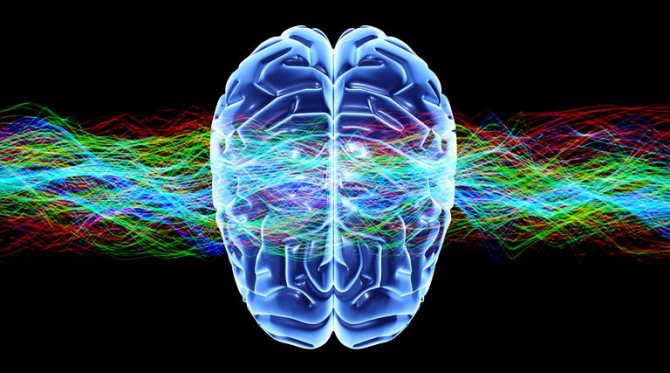
Causes
Synesthesia in psychology is a special phenomenon that is considered by psychologists exclusively as a feature of the functioning of the psyche, and not as a deviation. True, some experts admit that synesthesia can be a symptom of a neurological disorder without being a pathology.
Based on the above theories of the occurrence of this phenomenon, the reasons for the development of synesthesia in individuals are:
| Natural | The results of genealogical and molecular genetic studies indicate with a high degree of probability that the main mechanism for the development of synesthesia is a hereditary factor. |
| Human cognitive activity | The hereditary factor manifests itself precisely due to the cognitive activity of a person, starting from an early age, and if a child who is initially prone to synesthesia is not raised, then his synesthesia may not manifest itself in any way. |
| Special structure of the brain | This can be seen in his work at both the macro and micro levels. The brain of synesthetes is characterized by superplasticity in the perception of ordinary things, as a result of which simultaneous interaction between its various zones is activated. |
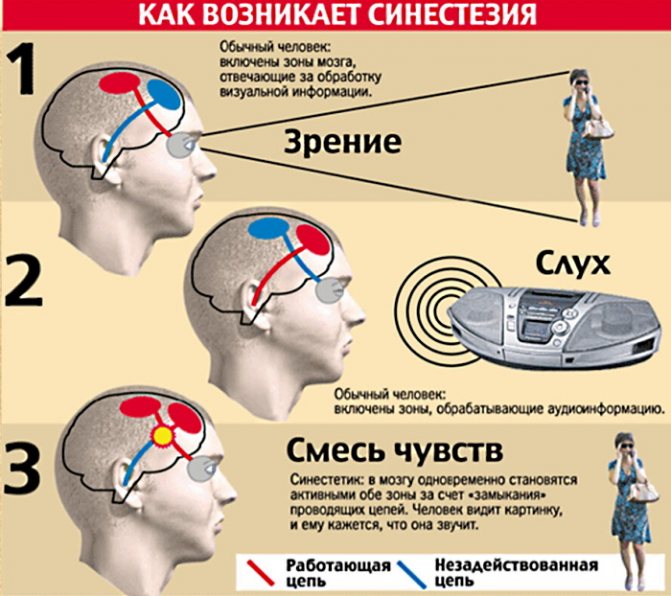
Sometimes synesthesia can develop as a result of traumatic influences, for example, after a head injury or a stroke. At the same time, the causes of synesthesia are not serious mental illnesses - schizophrenia, psychosis.
Summarize
I hope that after reading this article, you will have clarity in determining which type of testing you use at which stage, and what the difference is between these types of testing.
As was mentioned at the beginning, the boundary between these concepts is very arbitrary and remains at your discretion within the framework of the project. UPD
: Often "consistency testing" or "sanity testing" is referred to as "sanitary testing". I think that this came about due to the phonetic properties of the English word sanity, which is similar in sound to something “sanitary”. Google Translate brings clarity. Both options are available on the Internet. Regarding this article, please consider “sanitary” testing as “consistency testing.”
Thanks to astenix for the tip
The influence of genetics
Synesthesia in psychology is a very interesting and little-studied phenomenon in which a person develops an unusual reaction to the perception of various things, when irritation of one sensory or cognitive system leads to an involuntary response in another system.
In fact, there is not much research on the problem of synesthesia and genetic predisposition to it. It is widely believed among researchers that synesthesia is common in people with autism spectrum disorders.
Scientists have identified a group of genes presumably responsible for the development of synesthesia. The proteins they encode are associated with the processes of axonogenesis (development of axons - special processes of nerve cells that are responsible for conducting impulses).
With a certain mutation, expression is observed in the visual and auditory cortex, as well as the parietal region of the brain at the stages of its early development - from the 12th week of fetal development up to 3-4 years, when the first manifestations of synesthesia become noticeable in adults.
Genome screening of individuals with synesthesia made it possible to identify a whole complex of genes responsible for a predisposition to this phenomenon. However, at the same time, it was found that genetics does not always play a decisive role in whether a given feature will somehow manifest itself or not.
For example, there is a known case when 2 couples, carriers of the genes responsible for synesthesia, were born monozygotic twins and in each pair one child did not have any manifestations of this phenomenon.
In addition, researchers state that the occurrence of synesthesia, in addition to the hereditary factor, is influenced by educational processes. The role of experience is important here and the child will not necessarily perceive letters or other signs and symbols in the same tones as the synaesthete parent, since in the process of development he may develop his own sensitive images and associations, different from the parents.
Also, often synesthesia is not transmitted directly from parents to children, but manifests itself through generations.
What about people who can hear silent video?
Synesthesia doesn't just apply to people who associate certain colors with images. Some people are able to hear sounds and watch videos when there is actually no sound playing. Psychologist Chris Fassinge calls this phenomenon "visually evoked auditory response." Although this is not technically synesthesia, Fassinge believes it is a so-called new form of it that requires further study. “Some people describe it as a buzzing in their head,” Fassinge said.
A 2008 study shows that visually evoked auditory response is quite common. It affects 20 to 30 percent of people. Moreover, some people are not aware that they have this type of synesthesia. To do this, you must undergo appropriate testing.
A girl can easily “turn” into cartoon characters with the help of makeup
Challenge accepted: grow crops in the sea and feed millions of people
A family of 4 lives happily in a cozy mobile home with an area of 21 sq.m.

Types of synesthesia
Synesthesia can manifest itself in absolutely any emotions and modalities, and in psychology there is at least one known case where synesthesia covered all 5 senses.

This phenomenon was possessed by the synesthete Solomon Shereshevsky, a famous mnemonist and a person with a unique memory. Despite the fact that almost any combination can be observed with synesthesia, psychologists still group sensitive manifestations according to several criteria.
- Phonopsia (chromesthesia) is a common type of synesthesia in which sounds and colors are combined. The trigger may not necessarily be music; in some people, sounds such as the creaking of a door opening, a car horn, or the noise of a train can trigger visions of color. In this case, the colors that appear before the eyes or in the mind under the influence of sounds are called photisms. If we talk about musical inclinations and abilities, then many composers have a synesthetic color hearing. Many singers, musicians and composers associate tonality, notes and melodies with certain colors and shades. Moreover, each musician sees the same sounds in his own way, and the same melody can be seen by different synesthetes prone to chromesthesia in different tones (for example, a major combination of B-flat can be lemon-colored for one synesthete, and dark purple for another ).
- Grapheme-color – associated with the emergence of graphic and color associations when mentioning or visualizing letters, numbers and words. For most of these people, any symbol evokes associations with one shade or another. An interesting fact is that as a result of studies, it was revealed that many synesthetes identify the letter “A” with red.
- Kinesthetic-sound - characterized by the ability of individuals prone to synesthesia to hear certain sounds when observing any moving objects or ongoing events, even if they are not actually represented by sound coloring.
- Lexical-gastic is a rather rare form of synesthesia, in which a person develops gastronomic taste identifications from words and images. Such people, when listening to their favorite melody or song, may feel the taste of chocolate or coffee in their mouth. Such sensations occur in less than 0.2% of the population.
- Numerical or sequence localization synesthesia is associated with the emergence of certain images and associative series when receiving certain digital information. Such people have excellent memory, and they see numbers and figures as series-sequences in space.
- Acoustic-tactile synesthesia is a rare type of synesthesia that is associated with the occurrence of certain sensations in different parts of the body in response to heard sounds.
- Misiphonia - in this form, certain sounds cause a whole range of negative experiences - anger, rage, hatred, disgust.
- Mirror - or otherwise synesthesia of touch empathy, a rather rare form of synesthesia manifested in the fact that a synesthete who observes another person, for example, being tapped on the shoulder, feels the same touches on his own body. Such synesthete people have a higher level of empathy - the ability to sympathize and empathize.
Study of synesthesia
As a mental phenomenon, synesthesia
has been known in science and medicine for several centuries. Among the famous people who were synesthetes were the composers A. Scriabin, who distinguished the color and even taste of musical notes, and N. Rimsky-Korsakov, who had a color hearing for pitch. The poet Arthur Rimbaud painted vowel sounds in different colors, and the artist V. Kandinsky could hear the sounds of colors.
There is still no consensus explaining the origin of synesthesia
. According to one version, its development begins in infancy. In the brain of newborns, impulses emanating from the sensory organs are mixed, but over time, as a result of the death of neurons that form the so-called synaptic bridges, their separation begins. In synesthetes, this process does not occur, so they remain “happy babies” throughout their lives.
Interestingly, “connecting” different senses and using them in unusual contexts is one of the principles of neurobics - a brain exercise that prevents the brain from stagnating. Of course, neurobic exercises do not involve “seeing” numbers or “listening” to colors, but they can involve getting dressed with your eyes closed or smelling perfume while listening to music.
(due to the irradiation of excitation from the nervous structures of one sensory system to another), along with sensations specific to it, it also causes sensations corresponding to another sense organ.
Taste synesthesia
- the appearance of taste associations from any words or images. Such synesthetes may, for example, hear their favorite song every time they eat chocolate.
The most common synesthetes are those with color or texture associations with letters, numbers, and words (for example, the letter A always appears bright green).
The phenomenon of synesthesia has been known to science for three centuries. The peak of interest in it came at the turn of the 19th and 20th centuries. Then not only doctors, but also people of art became interested in the mixture of feelings. So, in 1915, a special instrument was created to perform the lighting part in “Prometheus” by Alexander Scriabin. In the 1970s, “music + light” concerts were popular, which used a “light organ” - a musical instrument that produced not only sounds, but also light.
The origins of the reasons for the connection of visible and audible perception on human receptors go back centuries. Even in ancient times, there was an art called syncretism, that is, indivisible into genera and types. Color and sound in the minds of primitive ancestors belonged to certain objects, and the perception of objects was specific. That is why the dance and the light from the flame of the fire, which were obligatory ritual actions, were inseparable and were performed in certain and designated cases.
It should be noted that synesthesia is not a mental disorder.
How do synesthetes think?
According to one theory, the emergence of additional images is closely related to an increase in cross-connections between areas of the brain responsible for different functions. According to another opinion of researchers, such a reaction occurs due to a decrease in inhibition of existing feedback pathways, when the stimulus is evaluated by more than one area of the brain, but additional areas are activated.
Psychologists also note that most synesthetes themselves strive for stimuli that can cause similar reactions in them and have great sensitivity.
It should be understood that synesthetes do not always literally see letters or numbers in a certain color in front of their eyes (or maybe even this) - their reaction may be associated with some emerging image or impression in their head.
Notes
Wikimedia Foundation.
2010. Synonyms
:
See what “Synesthesia” is in other dictionaries:
- - (from the Greek synaisthesis co-sensation) a phenomenon of perception when, when a given sense organ is irritated, along with sensations specific to it, sensations corresponding to another sense organ arise (for example, color hearing, sound experiences ... ... Big Encyclopedic Dictionary
- (from other Greek synaisthesis co-sensation) A concept meaning a form of perception characterized by connections between feelings in the psyche, as well as the results of their manifestations in specific areas of art: a) poetic tropes and stylistic figures, ... ... Encyclopedia of Cultural Studies
- (Greek) accompanying, secondary representation; the fact that when any sensory organ is irritated, not only a sensation corresponding to it arises, but at the same time a sensation corresponding to another sensory organ. So, at the sound of a trumpet... ...Philosophical Encyclopedia
- [German] Sunästhesie Dictionary of foreign words of the Russian language
Synesthesia
— Synesthesia: interactions in the process of sensory reflection of perceived information in thinking with the formation of intersensory connections...
Synesthesia (from the Greek synáisthesis - feeling, simultaneous sensation, antonym to the concept of "anesthesia" - absence of any sensations) is a feature of human perception, characterized by the fact that the response of the senses to a stimulus is accompanied by other, additional sensations or images. One example of manifestation is sound associations when perceiving a color. This phenomenon is not so rare, but often the same tonality can evoke completely different color ideas in different people.
Based on the nature of the additional sensations that appear, the following types of synesthesia are distinguished:
- visual (photism);
- auditory (phonisms);
- taste;
- tactile and so on
Synesthesia can occur selectively, i.e. only to certain impressions, and extend to almost all sensations of the senses. The most relevant study of this phenomenon became at the turn of the 19th and 20th centuries. At that time, not only psychologists and doctors, but also people of art became interested in this phenomenon. Then the phenomenon of synesthesia forced the musician A. Scriabin to think about “synthetic art”, where each musical key would correspond to a specific color (symphonic poem “Prometheus”, 1910). At the same time, French symbolists (Arthur Rimbaud, Paul Verlaine, Charles Baudelaire) created famous sonnets dedicated to sounds and colors. Many writers, poets and artists can be classified as “synesthetics”, although at first glance they seem very different: V. Kandinsky and L. Tolstoy, M. Tsvetaeva and M. Gorky, V. Nabokov and K. Balmont, B. Pasternak and A. Voznesensky.
"Synesthetic" associations can sometimes be very unpredictable and fantastic, and sometimes even "supernatural". Thus, people, who at first glance are no different from others, sometimes categorically assert that individual words, letters and numbers have their own innate colors, and often even many years are not able to change this opinion.
In 1996, Simon Baron-Cohen, together with other employees at the University of Cambridge, found that approximately one person in two thousand has such “hard” associations, and most likely this can be transmitted genetically, by inheritance. However, other data claim that 1 person out of 25 thousand has such features. By the way, there are much more women synesthetes than men: in the USA 3 times, and in England 8 times. Such people are mostly left-handed, or are equally good with both their right and left hands. Synesthetes are not particularly strong in mathematics, they are often absent-minded and have worse spatial orientation than others.
A new study by Megan Stephen from the University of Oxford has proven that although the role of genes in synesthesia remains the leading one, this phenomenon cannot be determined by genetics alone. Stephen and her colleagues examined 6 synesthetic people who became blind in adulthood and found that three of them developed such abilities after they were completely blind. Thus, one of them, after losing his sight, began to consider all days, months, letters and sounds to be “colored” in certain colors, and the other began to see various images in front of him with sounds and smells.
Baron-Cohen agrees that the formation of this phenomenon is influenced not only by genes, but also by the situation and environment. But he believes that we still need to learn to distinguish true from false. So, for example, one should not consider the colors of a patient who went blind for 5 days to be synesthesia, because they resemble this phenomenon only externally.
In everyday life, we constantly use our senses - we inhale the smell of fresh bread, admire the beauty of nature, listen to the masterpieces of classical composers, enjoy the taste of ice cream, and touch soft silk with pleasure. Using one of the senses to study any subject is a normal human condition. Yes, we can see bread, smell it, touch and taste it, but who would think to think about what fresh bread sounds like? It turns out that some people are able to use all five senses at once to study a subject. This phenomenon is called synesthesia.
Feature or disorder?
Synesthesia in psychology is a phenomenon associated with the characteristics of perception, in which irritation of one sense organ causes sensations associated with other sense organs.
Some practitioners recognize synesthesia as a neurological disorder, but it is not included in either the ICD (International Classification of Diseases) or the International Classification of Mental Disorders because in most cases it does not interfere with daily activities.
As a result, it can be unequivocally stated that synesthesia is more a feature than a mental disorder. Most synesthetes perceive their state as neutral or as an additional pleasant bonus, thanks to which they have absolute pitch or other creative abilities.
Synesthesia can only be a symptom of some serious diseases (autism), and in itself is not a deviation.
“If you hope to experience Synesthesia, learn to meditate.”
Meditation cultivates synesthesia. In the Sensorium, you find over 150 exercises, which engage all your senses. These mindful and synesthetic activities support you in discovering and experiencing synesthesia in your daily life.
Take 10 minutes and start now for free!
Or visit our test series.
Get the Synesthesia Meditation App on Google Play
Dr. Wozniczka is a Chicago-based internal medicine physician with experience in Eastern Europe, Southeast Asia, and Sub-Saharan Africa. Graduated from the Jagiellonian University in 2014. He holds an MBA and an MPH from the University of Illinois at Chicago.
Number of sources used in this article: . You will find a list of them at the bottom of the page.
Synesthesia is a rare phenomenon of mixing of the senses (vision, hearing, taste), in which stimulation of one sense leads to a predictable and reproducible response of the other. For example, a person with synesthesia may hear colors, feel sounds, or taste objects when touched. Sometimes these feelings are completely subjective. Most people with synesthesia are born with it and do not consider their sensations to be anything strange. When they tell people about how the world around them appears before them, they begin to be treated like crazy. A diagnosis of synesthesia usually comes as a real relief to them. Please note that the medical community does not agree that this condition even exists, and therefore some doctors do not consider synesthesia to be a real disease.
Diagnostics
To diagnose synesthesia, a simple color perception test is used. Its essence lies in the fact that a person is shown several colors, and then after some time they are asked to reproduce the exact sequence in which this happened.
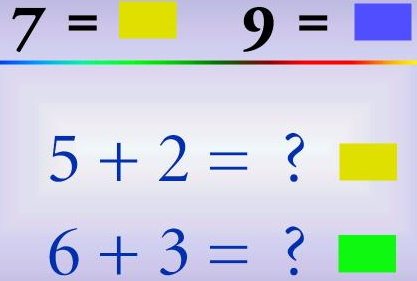
For a synesthete, such a task will be very easy to complete even months later, but among ordinary people the coincidence rate is no more than 30%.
It should be noted that it is difficult to identify this feature for sure, so in addition to testing, pay attention to such signs as:
- having excellent memory;
- similarity of the phenomenon with the state of affect;
- automaticity of human reactions to a stimulus.
Synesthesia test
Over the years of research, psychologists have come up with many different ways to identify sensation synesthesia in men and women.
The photo below shows one of these tests for synesthesia. The task assigned to you is very simple - to find twos on the digital field. Try to do this without stopping to read the text under the picture. Once you complete the task, continue reading to find out the purpose of the test and draw certain conclusions. The average person will spend more time on this task than a synesthetic person will. The latter will instantly identify twos by color. For him, everything is simple: the number 2 is orange, and all the fives presented are green. Why is that? People first of all see, look for the outline of an object, then only realize its color; for a synesthete, everything is completely different.
Treatment
Since this phenomenon is not a disorder or a medical diagnosis, there are no specific medications or medical protocols for treating this condition. However, in some cases, synesthetes need help. Such a need may be necessary when, due to emerging images, a person experiences disgust or irritability and this interferes with his life.
In these cases, mild sedatives are prescribed to help the person more calmly perceive his or her peculiarity. Also, if a synesthete complains of a lack of rest and sleep problems, sleeping pills can be prescribed to help the person rest from obsessive images.
If it is difficult for a synesthete to accept himself and his peculiarity, a psychotherapist can come to his aid, who individually, using special techniques, will help relieve the psychological pressures and problems that have arisen.
How to develop synesthesia?
Some people wonder whether it is possible to develop synesthetic abilities. An ordinary person will not be able to specifically train his brain or sense organs in any way to perceive reality synesthetically, just as synaesthetes cannot, through an effort of will, stop being the owners of such a feature.
However, medicine knows situations where people suddenly, after certain events in life, discovered synesthetic abilities.
For example, there is a well-known story of a Toronto resident who, at the age of 45, after suffering a stroke, suddenly began to experience irritation from words written in a particular color and complained that the color blue associated him with the smell of berries.
All these manifestations, which he had not encountered before, caused him fear, and he turned to doctors. After an MRI examination, it turned out that after the attack, his brain tried to restore its previous functioning, as a result of which disordered connections formed between individual cells.
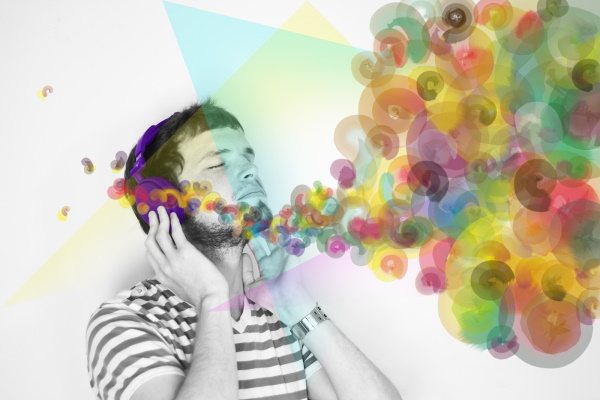
Also, scientists have repeatedly made attempts to artificially develop synesthesia in people, but they were not successful.
Many of them agreed that the basis of the phenomenality of this phenomenon lies precisely in the factor of spontaneity, which in an artificial attempt to recreate such a special perception is simply absent, and there are no techniques or methods or medications that would be able to reproduce these sensations.
However, in 2020, one of the American engineers created an artificial simulator, which is a special mask that allows you to feel like a synesthete. This simulator consists of a special mask and a sensor on the hand, with which you can analyze objects and smell different smells depending on their color.
What is synesthesia
Synesthesia is a mode of perception in which signals from one sensory or cognitive system are echoed in another system. In practice, this means that a person perceives symbols, names and titles, his own states (for example, emotions or pain), and various categories in a special way. They are complemented by other sensations and ideas: smell, taste, color, shape, volume, sense of location in space. Additional sensations are not the result of sensory experience - they come associatively: for example, a synesthete may perceive the number two as purple or believe that Tuesday is located in his “mind chamber” on the right.
For example, all people with a vivid imagination are capable of connecting visual images and words. But in the case of fantasy, it is more about an artistic metaphor, and the image itself can change depending on the circumstances. For a synesthete, the sensations will be constant: a specific sign or, for example, a day of the week will be constantly assigned its own color. It is believed that these rules are set by the brain itself, and decisions about connections are made unconsciously. A synesthete has no rational basis for why a particular word is blue and not green - it’s just “that’s how he sees it.” “Usually, when I talk about the colors of letters and words, my interlocutors interrupt: “Oh, of course, in kindergarten they showed letters of different colors.” But this is not true at all. The color of the letters came from my head, especially since I came to kindergarten already reading fluently,” says synesthete Olga Lukinskaya.
Speaking about the number of synesthetes in the world, different figures are given, from 0.05 to 4% of the total population. Synesthesia is not classified as a mental disorder or brain disorder; it is called a perceptual feature or a neurological phenomenon. However, some people with synesthesia say that intense sensations can cause too much stress. “Often synesthesia contributes to sensory overload, often it just happens and goes away,” says synesthete Daria.
A synesthete has no rational basis for why a particular word is blue and not green - it’s just “that’s how he sees it”
The additional qualities of objects and phenomena that a synesthete perceives are illusory and also subjective - so it is difficult for them to find any practical application. On the other hand, synesthesia is often perceived as a “superpower.” Despite the fact that synesthetes themselves do not always look at it this way, the fact that phenomena and sensations are involuntarily combined can help create artistic images. It is no coincidence that many famous people in art and science were synesthetes - they include, for example, the father of abstract art Wassily Kandinsky, physicist Richard Feynman (who, in addition to being a Nobel laureate in physics, studied art and participated in experiments on sensory deprivation), and from our contemporaries - Geoffrey Rush, Tori Amos and Aphex Twin.
However, there are discrepancies here - for example, linguist and synesthesia researcher Anton Sidorov-Dorso calls Kandinsky’s synesthesia mythical: “The wealth of transitions between various “pure” images belonging to different spheres of sensuality to which Kandinsky refers, their intricate, intellectual load speaks rather of the endless sensory-symbolic fantasy of the artist than about the presence of constant correspondences in him, known today under the term “synesthesia.”
Examples of synesthesia
Among the entire population, synesthetes make up no more than 4%, but the world knows many such people due to the fact that most of them have outstanding creative abilities. The most striking example is the Nabokov family, in which this feature was passed on to the writer from his mother, and from him to his son Dmitry.
It is known that the writer and his mother saw letters in the same tones, and also musical notes affected both of them optically, visualizing themselves in specific images.
There are a lot of synesthetes among famous musicians. The Ukrainian composer and singer Scriabin could distinguish notes by color and even taste, and the composer Rimsky-Korsakov distinguished the pitch of notes by tones and shades.
Painters are also characterized by synesthesia. For example, the artist Kandinsky could distinguish the colors of paints by sound. There are many examples of synaesthetes among foreign creative intelligentsia. These are the Japanese pianist and composer Hiroma Uehara, who perceived music in color, Patricia Lynn Duffy, the English writer for whom the letters were not black and white, but colored.
Is it possible to pretend to be a synesthete?
Many people, being synesthetes, may not even be aware of their peculiarity, since it does not necessarily always reveal the creative potential of the individual. Sometimes people deliberately try to develop synesthesia in themselves in order to better understand certain phenomena and maximize their abilities. But learning synesthesia will not be possible on purpose.
It cannot be interpreted by lived experience and sensations or learned associations. It occurs under the influence of additional neural connections in the brain, so it is not difficult to recognize a person who is trying to imitate synesthesia.
Synaesthetes, when describing their sensations, react quickly, even lightning fast, since they do not need time to invent them, whereas when pretending, a person will not give such a reaction. All doubts can be finally dispelled using MRI. In synesthetes, unlike people with normal perception, unusual metabolic activity is recorded in certain areas of the brain.
In psychology, the concept of synesthesia is considered, first of all, as a feature of worldview. This phenomenon is not considered a mental disorder or disease. The attitude of people who have this feature of worldview towards synesthesia is ambiguous.
For some people, synesthesia has become a gift and has allowed them to reveal their creative abilities, achieve high-quality fulfillment and development. Other people have to struggle with their peculiarity, since the images that arise can reduce concentration and distract attention, which, on the contrary, prevents them from achieving success in any area.
What causes?
Approximately 40% of synesthetes have relatives of the first category with severe synesthesia. “I definitely played with it when I was 5 or 6 years old. I remember raiding my parents' office, looking for records that I liked and listening to them by color,” said Sean Day, a synesthete who associates colors with sounds and tastes. A 2020 study by scientists from the Max Planck Institute for Psycholinguistics and the University of Cambridge analyzed DNA samples from several families with generations of synaesthetes.
They concluded that the DNA differed in its variations, but had a common feature. There was an upregulation of genes involved in cell migration and axonogenesis, the process that allows brain cells to connect to their correct partners. "This study shows how genetic variation can change our sensory experience," said Professor Simon Baron-Cohen. Synesthesia is a prime example of neurological diversity that needs to be studied and taken into account.
Other experts believe that anyone can be born with synesthesia. Daphne Maurer, a psychologist at McMaster University, suggests that we may all be born with special neural connections that allow the development of synesthesia. However, many simply lose this ability as they grow older. Research shows that people may associate bright colors with high volume and dark liquids with stronger odors. Such analogies are “echoes” of synesthesia, which over the years began to manifest itself to a lesser extent.
10 Best Examples of Fun Deadpool Tattoos
Another story of Princess Diana: starring Kristen Stewart
Horseshoe crab - an endangered living fossil that could save us from the "corona"
